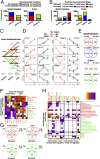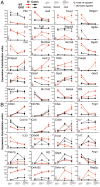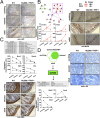Analysis of gene-environment interactions in postnatal development of the mammalian intestine - PubMed (original) (raw)
Analysis of gene-environment interactions in postnatal development of the mammalian intestine
Seth Rakoff-Nahoum et al. Proc Natl Acad Sci U S A. 2015.
Abstract
Unlike mammalian embryogenesis, which takes place in the relatively predictable and stable environment of the uterus, postnatal development can be affected by a multitude of highly variable environmental factors, including diet, exposure to noxious substances, and microorganisms. Microbial colonization of the intestine is thought to play a particularly important role in postnatal development of the gastrointestinal, metabolic, and immune systems. Major changes in environmental exposure occur right after birth, upon weaning, and during pubertal maturation into adulthood. These transitions include dramatic changes in intestinal contents and require appropriate adaptations to meet changes in functional demands. Here, we attempt to both characterize and provide mechanistic insights into postnatal intestinal ontogeny. We investigated changes in global intestinal gene expression through postnatal developmental transitions. We report profound alterations in small and large intestinal transcriptional programs that accompany both weaning and puberty in WT mice. Using myeloid differentiation factor 88 (MyD88)/TIR-domain-containing adapter-inducing interferon-β (TRIF) double knockout littermates, we define the role of toll-like receptors (TLRs) and interleukin (IL)-1 receptor family member signaling in postnatal gene expression programs and select ontogeny-specific phenotypes, such as vascular and smooth muscle development and neonatal epithelial and mast cell homeostasis. Metaanalysis of the effect of the microbiota on intestinal gene expression allowed for mechanistic classification of developmentally regulated genes by TLR/IL-1R (TIR) signaling and/or indigenous microbes. We find that practically every aspect of intestinal physiology is affected by postnatal transitions. Developmental timing, microbial colonization, and TIR signaling seem to play distinct and specific roles in regulation of gene-expression programs throughout postnatal development.
Keywords: innate immunity; intestine; microbiota; ontogeny; postnatal development.
Conflict of interest statement
The authors declare no conflict of interest.
Figures
Fig. 1.
Experimental design and primary datasets. MyD88+/− TRIF+/− mice were bred to create WT and MyD88−/− TRIF−/− littermates. Whole genome intestinal gene expression was measured in the small and large intestine in suckling, weaned, and adult mice. Pairwise comparisons of gene expression over developmental stage or genotype (1° datasets) are listed in Dataset S1, Tables A–X.
Fig. 2.
Trends in the developmental regulation of intestinal gene regulation. Number of probes up- and down-regulated by weaning and adulthood developmental transition (A) and by TLR/IL-R (TIR) signaling at each postnatal stage (B). (C) Number of probes demonstrating each of 10 different patterns of postnatal developmental kinetics, with specific examples in both the small intestine and colon (D). (E) Venn diagram of the number of probes present in secondary datasets for classification of genes with coordinate regulation by postnatal development and TLR/IL-R (TIR) signaling, with the inclusion of microbe-regulated genes compiled by metaanalysis (G) (SI Appendix, Fig. S1). (F) Heatmap of enrichment between developmentally and TLR/IL-R (TIR)-regulated 1° datasets, with the inclusion of microbe-regulated genes compiled by metaanalysis (H). Rows ending with numbers in superscript refer to microbe-regulated datasets from the study of the corresponding Supplemental Reference number. All heatmap colors are statistically significant enrichment by hypergeometric test (negative log P value < −1.5). Green and striped boxes are discussed in section Role of TIR Signaling on Postnatal Developmental Phenotypes. Error bars, SEM.
Fig. 3.
Developmental, TLR/IL-R, and microbiota transcriptional regulation of metabolism and host defense. Gene expression by postnatal developmental stage in the small intestine and colon for metabolism (A) and host defense (B) related genes. TLR/IL-R (TIR) and/or microbe icons indicate regulation coordinate with the developmental trend. Error bars, SEM.
Fig. 4.
Role of TLR/IL-R signaling on postnatal developmental phenotypes. (A) Immunohistochemistry with αWF Ab to identify vascular endothelium in the small intestine. (B) GenoGo MetaRodent TF subnetwork enrichment for c-Myc among regulated developmentally induced and TIR coordinately regulated genes in the small intestine (Upper Left). Expression of selected genes in WT and DKO small intestines over postnatal developmental stage (Lower Left). Immunohistochemistry with αBrDU Ab at the small intestine of mice treated with BrDU pulse (Right). (C) DAVID bioinformatic analysis of developmentally repressed genes with increased expression in WT compared with DKO colons (Fig. 2_F_, blue striped box) (Top). Expression of selected genes in WT and DKO in the colon over postnatal developmental stage (Middle). Immunohistochemistry with αSMA Ab to identify smooth muscle cells present in the colon (Bottom). (D) DAVID bioinformatic analysis of genes overexpressed in DKO colons compared with WT at weaning (overlap with Fig. 2_F_, pink striped box) (Upper Left). Expression of selected genes in WT and DKO colons over postnatal development (Lower Left). Immunohistochemistry with αcKit Ab to identify mast cells present in the colon (Right). (Magnification: A_–_C, 200×; D, 400×.) Counterstains are hematoxylin. Error bars, SEM.
Similar articles
- Inhibition of TIR domain signaling by TcpC: MyD88-dependent and independent effects on Escherichia coli virulence.
Yadav M, Zhang J, Fischer H, Huang W, Lutay N, Cirl C, Lum J, Miethke T, Svanborg C. Yadav M, et al. PLoS Pathog. 2010 Sep 23;6(9):e1001120. doi: 10.1371/journal.ppat.1001120. PLoS Pathog. 2010. PMID: 20886104 Free PMC article. - Aging and contribution of MyD88 and TRIF to expression of TLR pathway-associated genes following stimulation with Porphyromonas gingivalis.
Shaik-Dasthagirisaheb YB, Huang N, Weinberg EO, Shen SS, Genco CA, Gibson FC 3rd. Shaik-Dasthagirisaheb YB, et al. J Periodontal Res. 2015 Feb;50(1):89-102. doi: 10.1111/jre.12185. Epub 2014 May 24. J Periodontal Res. 2015. PMID: 24862405 Free PMC article. - New insights into the interplay between autophagy, gut microbiota and inflammatory responses in IBD.
Larabi A, Barnich N, Nguyen HTT. Larabi A, et al. Autophagy. 2020 Jan;16(1):38-51. doi: 10.1080/15548627.2019.1635384. Epub 2019 Jul 9. Autophagy. 2020. PMID: 31286804 Free PMC article. Review. - SIGIRR, a negative regulator of TLR/IL-1R signalling promotes Microbiota dependent resistance to colonization by enteric bacterial pathogens.
Sham HP, Yu EY, Gulen MF, Bhinder G, Stahl M, Chan JM, Brewster L, Morampudi V, Gibson DL, Hughes MR, McNagny KM, Li X, Vallance BA. Sham HP, et al. PLoS Pathog. 2013;9(8):e1003539. doi: 10.1371/journal.ppat.1003539. Epub 2013 Aug 8. PLoS Pathog. 2013. PMID: 23950714 Free PMC article. - Modulation of Toll-interleukin 1 receptor mediated signaling.
Li X, Qin J. Li X, et al. J Mol Med (Berl). 2005 Apr;83(4):258-66. doi: 10.1007/s00109-004-0622-4. Epub 2005 Jan 21. J Mol Med (Berl). 2005. PMID: 15662540 Review.
Cited by
- Induction of natural IgE by glucocorticoids.
Lim J, Lin EV, Hong JY, Vaidyanathan B, Erickson SA, Annicelli C, Medzhitov R. Lim J, et al. J Exp Med. 2022 Oct 3;219(10):e20220903. doi: 10.1084/jem.20220903. Epub 2022 Sep 13. J Exp Med. 2022. PMID: 36098746 Free PMC article. - Unique Gene Expression Signatures in the Intestinal Mucosa and Organoids Derived from Germ-Free and Monoassociated Mice.
Janeckova L, Kostovcikova K, Svec J, Stastna M, Strnad H, Kolar M, Hudcovic T, Stancikova J, Tureckova J, Baloghova N, Sloncova E, Galuskova K, Tlaskalova-Hogenova H, Korinek V. Janeckova L, et al. Int J Mol Sci. 2019 Mar 29;20(7):1581. doi: 10.3390/ijms20071581. Int J Mol Sci. 2019. PMID: 30934845 Free PMC article. - Postnatal epigenetic regulation of intestinal stem cells requires DNA methylation and is guided by the microbiome.
Yu DH, Gadkari M, Zhou Q, Yu S, Gao N, Guan Y, Schady D, Roshan TN, Chen MH, Laritsky E, Ge Z, Wang H, Chen R, Westwater C, Bry L, Waterland RA, Moriarty C, Hwang C, Swennes AG, Moore SR, Shen L. Yu DH, et al. Genome Biol. 2015 Sep 30;16:211. doi: 10.1186/s13059-015-0763-5. Genome Biol. 2015. PMID: 26420038 Free PMC article. - Resistant Starch is Actively Fermented by Infant Faecal Microbiota and Increases Microbial Diversity.
Gopalsamy G, Mortimer E, Greenfield P, Bird AR, Young GP, Christophersen CT. Gopalsamy G, et al. Nutrients. 2019 Jun 14;11(6):1345. doi: 10.3390/nu11061345. Nutrients. 2019. PMID: 31208010 Free PMC article. - Intestinal Epithelial Organoids as Tools to Study Epigenetics in Gut Health and Disease.
Kraiczy J, Zilbauer M. Kraiczy J, et al. Stem Cells Int. 2019 Jan 27;2019:7242415. doi: 10.1155/2019/7242415. eCollection 2019. Stem Cells Int. 2019. PMID: 30809264 Free PMC article. Review.
References
- West-Eberhard MJ. Developmental Plasticity and Evolution. Oxford Univ Press; Oxford, UK: 2003.
- Brandtzaeg P. The gut as communicator between environment and host: immunological consequences. Eur J Pharmacol. 2011;668(Suppl 1):S16–S32. - PubMed
- Walker WA. Initial intestinal colonization in the human infant and immune homeostasis. Ann Nutr Metab. 2013;63(Suppl 2):8–15. - PubMed
Publication types
MeSH terms
Substances
Grants and funding
- R01 AI089771/AI/NIAID NIH HHS/United States
- T32 HD055148/HD/NICHD NIH HHS/United States
- R37 AI046688/AI/NIAID NIH HHS/United States
- UL1 TR000142/TR/NCATS NIH HHS/United States
- R01 DK071754/DK/NIDDK NIH HHS/United States
- R01 AI046688/AI/NIAID NIH HHS/United States
LinkOut - more resources
Full Text Sources
Other Literature Sources
Molecular Biology Databases



